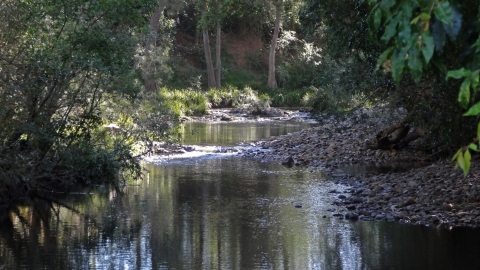- Home
- Assessments
- Bioregional Assessment Program
- Methods
- Groundwater modelling
Executive summary
The groundwater modelling provides key information for bioregional assessment (BAs), including estimates of the future groundwater regime within the subregion or bioregion, and, in particular, those aspects of the regime subject to hydrological changes due to coal resource development.
This submethodology gives a high-level overview of how groundwater modelling is undertaken in BAs and highlights linkages with other components of the BAs. It is not prescriptive in terms of model codes or approaches as there are substantial differences in data availability and potential coal resource development across the subregions and bioregions, which results in different model types and model codes in different BAs. Therefore this submethodology has been written at a conceptual level to be independent of any specific model code to remain generally applicable to all subregions or bioregions. Specific details for the chosen groundwater models will be included in product 2.6.2 (groundwater numerical modelling) for each Assessment.
An important distinction between the models used for BA and most groundwater models is that the BA models are designed around giving probabilistic predictions, this ensures that as much uncertainty as can be quantified is provided in the predictions. Generally, the type of modelling undertaken will be trajectory modelling. Two potential futures are considered in a BA:
- baseline coal resource development (baseline): a future that includes all coal mines and coal seam gas (CSG) fields that are commercially producing as of December 2012
- coal resource development pathway (CRDP): a future that includes all coal mines and CSG fields that are in the baseline as well as those that are expected to begin commercial production after December 2012.
The difference in results between CRDP and baseline is the change that is primarily reported in a BA. This change is due to the additional coal resource development– all coal mines and CSG fields, including expansions of baseline operations, that are expected to begin commercial production after December 2012. This manner of using groundwater models is different to the typical use for which many existing groundwater flow models were developed. Therefore, the use of existing models in BAs are evaluated in terms of their suitability for this purpose.
The groundwater modelling outputs hydrological response variables, the hydrological characteristics of the system or landscape class that potentially change due to coal resource development. The hydrological response variables for groundwater are:
- dmax: maximum difference in drawdown for one realisation within an ensemble of groundwater modelling runs, obtained by choosing the maximum of the time series of differences between two futures, with units of metres (m)
- tmax: year of maximum change, with units of years.
The groundwater model results are used to refine the surface water models, particularly for surface water ‒ groundwater interactions. The surface water model provides inputs to the boundary conditions of the groundwater model and the groundwater model provides inputs to the surface water model as changes in baseflow generation. The groundwater modelling also interacts with the BA process for placing receptors across the landscape.
A sensitivity analysis is conducted to identify the parameters that affect the hydrological response variables the most. The uncertainty due to the most important parameters is then quantified.
Results from the groundwater modelling are reported in product 2.6.2 (groundwater numerical modelling) and in product 2.5 (water balance assessment).
These results are used in subsequent receptor impact modelling and the impact and risk analysis in the BA.

Methodology Download
METHODOLOGY FINALISATION DATE
METHODOLOGY CONTENTS
- 1 Background and context
- 2 Modelling philosophy
- 3 Choice of model
- 4 Boundary conditions
- 5 Model time steps and predictive time frame
- 6 Integration with surface water modelling
- 7 Parameterisation
- 8 Calibration, sensitivity analysis and uncertainty analysis
- 9 Meeting the requirement for transparency
- 10 Outputs from groundwater modelling
- References
- Glossary
- Citation
- Acknowledgements
- Contributors to the Technical Programme
- About this submethodology
